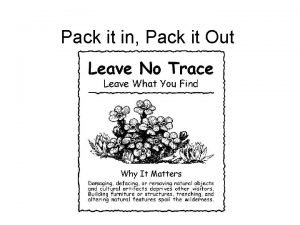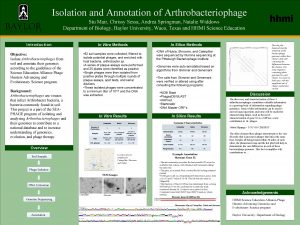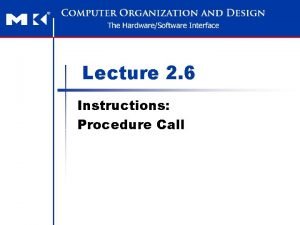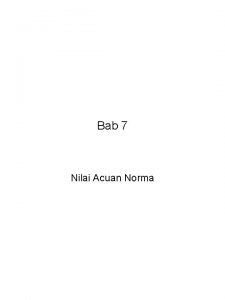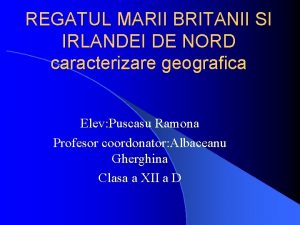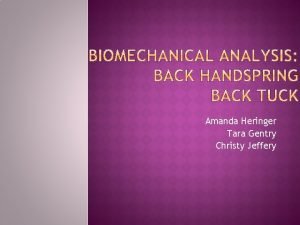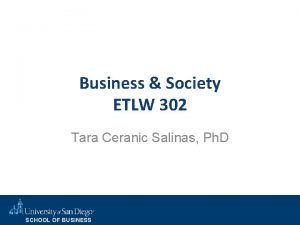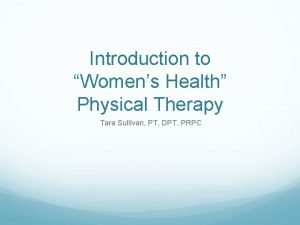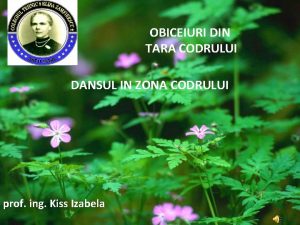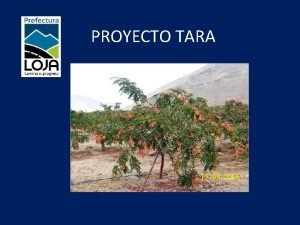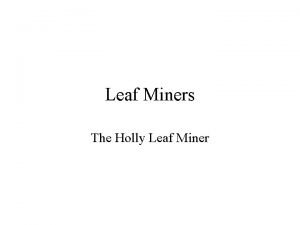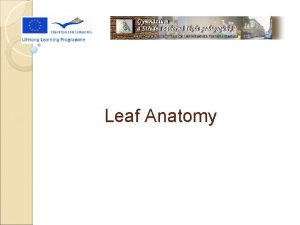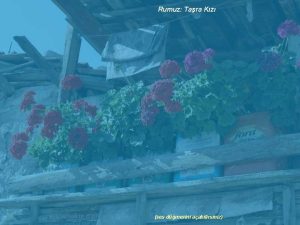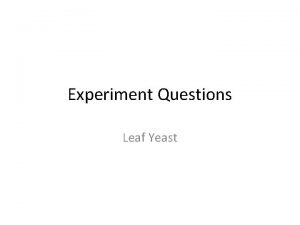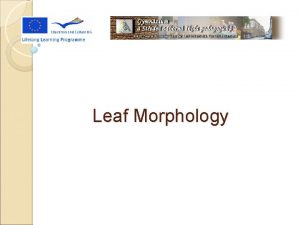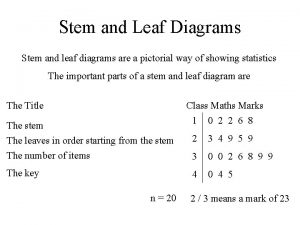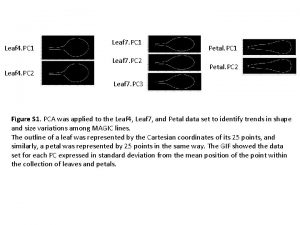Leaf Pack Ecology Chrissy Wilson 1 Tara Muenz
























- Slides: 24

Leaf Pack Ecology Chrissy Wilson 1, Tara Muenz 2, Dave Arscott 2 1 Ridley High School, Folsom, PA 2 Stroud Water Research Center, Avondale, PA

http: //www. stroudcenter. org/lpn/ v Dried leaves become homes for macroinvertebrates v Leaf packs replicate what happens in nature, allow for the study of the stream

Leaf Pack Background v ID macroinvertebrates v Determine health of stream v Rate of leaf decomposition v Food preferences of macroinvertebrates

Leaf Pack for High School? v Develop curriculum to meet state standards for high school students Hypotheses Tested v Total richness and abundance of macroinvertebrates will vary with leaf pack size v Leaf decomposition rates differ among levels of moisture, physical abrasion, and macroinvertebrate colonization

Methods: Leaf Pack Size v Dry, mixed leaf types were weighed then placed into onion bags v Both a tin foil label and paper label were used v 5 g, 10 g, 20 g, 30 g in triplicate v All deployed in forest riffle

Harvesting: Leaf Pack Size After 4 weeks in the stream. . . v Place leaf pack in 250 micron sieve then in ziplock bag v Open leaf packs in sorting tray, then rinse off all bugs in a sieve, preserve bugs in 95% ethanol

Does Size Matter? Total Invertebrate Abundance Number of Macroinvertebrate Taxonomic Groups 600 Taxonomic Groups (#) Individuals (#) 500 400 300 200 100 0 5 10 20 Leaf Pack Mass (g of leaves) 30 18 16 14 12 10 8 6 4 2 0 5 10 20 Leaf Pack Mass (g of leaves) • 20 gram leaf pack had the largest number of macroinvertebrates • 20 gram leaf pack had the most taxonomic groups 30

Does Size Matter? 600 Abundance (#) 500 400 300 200 100 0 5 5 5 10 10 10 20 20 Leaf Pack Size (grams) 20 30 30 30 LPN Macroinvertebrate Water Quality Score 6 5 4 WQS Leaf Pack Network Water Quality Scores were similar 3 2 1 0 5 10 20 Leaf Pack Mass (g of leaves) 30 Springtail Gastropoda Turbellaria Hirudinea Oligochaeta Amphipoda Other Diptera Tipulidae Chironomidae Athericidae Coleoptera Anisoptera Other caddisflies Hydropsychidae Plecoptera Ephemeroptera

Ridley High School Folsom, PA Wetlands Little Crum Creek Pond

RHS Leaf Packs Abundance Richness 600 10 9 500 8 400 7 300 5 6 4 200 3 2 100 1 0 0 WCC LCC-Rif RHS-Pond RHS-Wet WCC LCC-Rif RHS-Pond • White Clay Creek has far more macroinvertebrates than Ridley HS • Little Crum Creek can be compared to the pond and the wetland as a more rich and abundant area RHS-Wet

RHS Leaf Packs Water mite 600 Gastropoda Turbellaria 400 Hirudinea_x 000 d_ Oligochaeta 300 Isopoda 200 Amphipoda_x 000 d_ Other Diptera 100 Tipulidae H S- W et et Simuliidae R R H S- W et W S- R H Po nd R H S- -R if if LC C C -R LC C -R if LC C C W C C 0 W Abundance(#) 500 Site LPN Macroinvertebrate Water Quality Score 9 8 7 6 5 4 3 2 1 0 WCC LCC-Rif RHS-Pond RHS-Wet

Methods: Leaf Decomposition v Dry maple or oak leaves were weighed (10 g) then placed into onion bags v Both a tin foil label and paper label were used v 10 g/each, 5 bags of oak, 5 bags of maple per site (50 leaf packs total) v Dried O/N at 60°C v Deployed to 5 different sites at Stroud

Site 1: Meadow Riffle

Site 2: Flood Plain Wetland

Site 3: Forested Stream Edge

Site 4: Forested Riffle

Site 5: Forested Pool

Site 6: Control (greenhouse)

Methods: Leaf Decomposition Each week. . . v Gather 1 oak and 1 maple leaf pack from each site v Wash leaves of sediment and bugs, allow leaves to dry in greenhouse for 30 minutes v 60°C oven O/N, then obtain dry mass v Burn leaves in kiln v Obtain mass of ash

Leaf Pack Dry Mass Remaining (%) Maple Oak 100% 90% Dry mass remaining (%) 80% 70% 60% 50% 40% 30% Flood Plain Wetland Forested Stream Edge Forested Pool 20% 10% Forested Riffle 0% -5 5 15 Days 25 35 (5) 5 15 Days 25 35

Leaf Pack Organic Material Remaining (%) Maple Oak 100% Organic matter remaining (%) 90% 80% 70% 60% 50% 40% 30% 20% 10% 0% -5 5 15 Days 25 35 (5) 5 15 Days 25 35 v Dry Mass of Leaves – Ash = Organic Material Remaining v Sources of error: handling, humidity, less sensitive scale

Discussion v 20 g of leaves in a leaf pack allows for more diversity and abundance v Locations with more water and turbidity help to break down leaves more rapidly Questions to investigate further: Daily total precipitation (cm) 25 25 20 20 15 15 10 10 5 5 0 0 - 1 2 3 4 5 6 7 8 9 1 1 1 1 1 2 2 2 2 2 3 3 3 0 1 Days 2 3 from 4 5 start 6 7 of 8 Experiment 9 0 1 2 3 4 5 6 7 8 9 0 1 2 3 4 Daily average air temperature (o. C) How do precipitation and temperature impact the decomposition of leaves? 30 30

Back to the Classroom v Created a reference sample to help students identify macroinvertebrates commonly found on school grounds v Created a lesson plan to have students use leaf pack in the spring v Students will create their own leaf pack experiment – looking at variables like location, leaf type, and size of leaf pack – then carry out their experiment and analyze their data.

Acknowledgements v Thank you to Dr. Dave Arscott and Tara Muenz for all of your help with the research and data analysis! v Thank you to Tara Muenz and Dr. Anthony Aufdenkampe for the RET experience. v Caitlin and Steffani (Downingtown STEM Academy) for sorting v Sean Kelley for Leaf Pack in the classroom advice v NSF EAR 1263212 Introducing Critical Zone Observatory Science to students and teachers
 Pack in pack out
Pack in pack out Chrissy schmitzer
Chrissy schmitzer Chrissy sessa
Chrissy sessa Chrissy schmitzer
Chrissy schmitzer Chrissy benson
Chrissy benson Chrissy drew this graph
Chrissy drew this graph Leaf and non leaf procedure
Leaf and non leaf procedure Maple leaf and oak leaf homologous
Maple leaf and oak leaf homologous Penilaian acuan norma
Penilaian acuan norma Harta fizica marea britanie
Harta fizica marea britanie Back handspring slow motion
Back handspring slow motion Tara and tiree, fearless friends
Tara and tiree, fearless friends Tara szvet
Tara szvet Tara maltby
Tara maltby Tara ceranic salinas
Tara ceranic salinas Henry sullivan therapy
Henry sullivan therapy Tara reid
Tara reid Tara thieme
Tara thieme Dantul codrenesc
Dantul codrenesc Deirdre koppel
Deirdre koppel Proyecto tara
Proyecto tara Tara vojna ustanova
Tara vojna ustanova Tara bracco
Tara bracco Tara noble
Tara noble Proyecto tara
Proyecto tara
